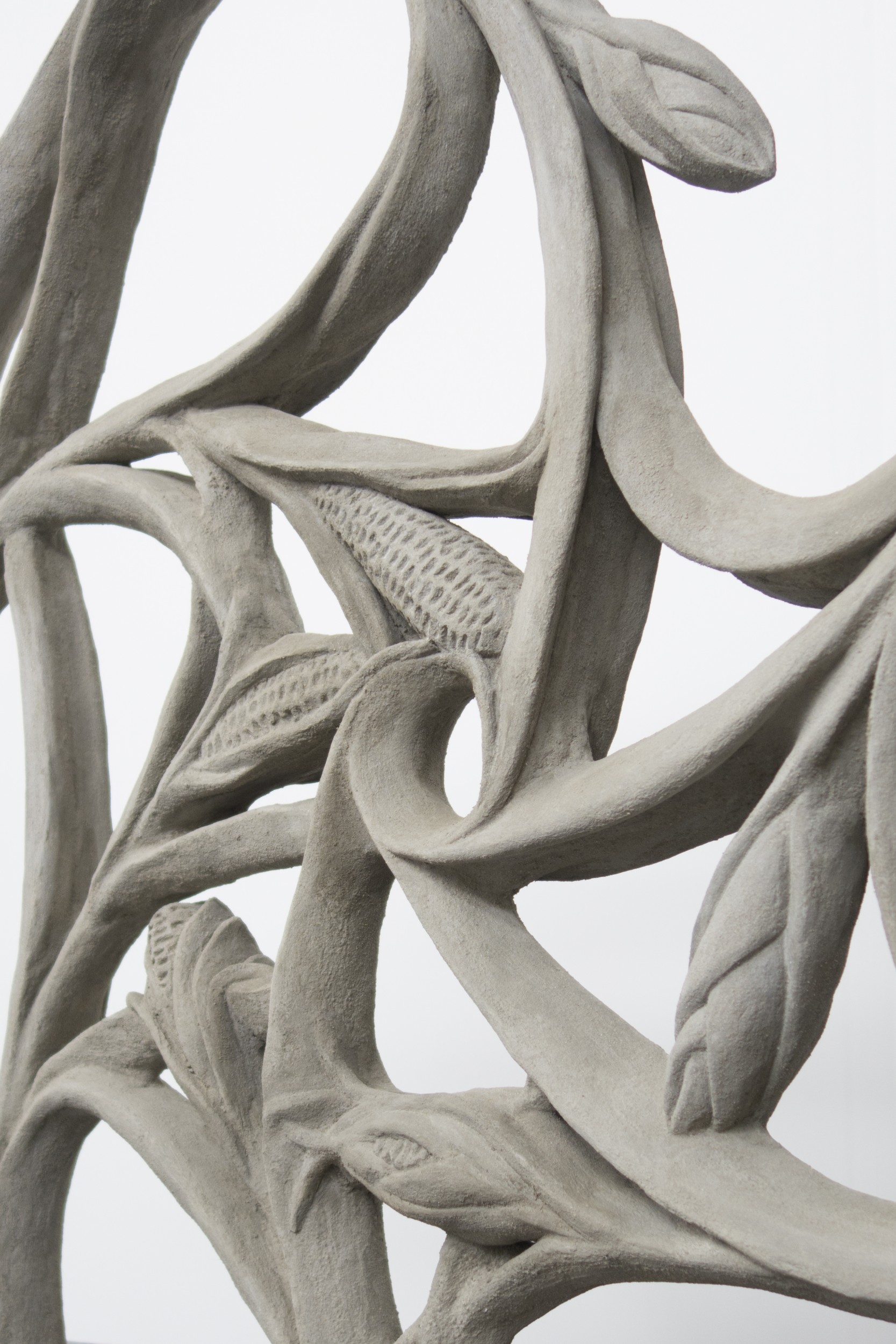Dust to Dust, Xolo Cuintle, 2023, concrete, steel, 115 × 115 × 15 cm, 2023, DS Galerie, Paris • © Valentin Vie Binet
Given the scarcity of young artists using concrete in their creations, the work of the Xolo Cuintle duo is worthy of note. Already established in the world of architecture, urban planning and industry, this material has found its way into the studio of Valentin Vie Binet and Romy Texier, prospering in their hands as if it were modelling clay destined to become a sculpture. Ever since they met at Ensaama in 2016 with the official formation of the team a few years later, the two artists shared the same aesthetic vocabulary for the redefinition of domestic objects and natural figures. “We are interested in a number of the properties of concrete, especially its capacity to materialise time. We sculpt it using a layering method that looks like a build-up of dust. Its sandy appearance contributes to this impression. It is also possible to use a stratification technique, similar to a geological layer. Our sculptures replicate ornaments and forms from disparate eras. What’s more, this grey material can be used to make connections by stitching together different temporalities and grafting different civilisations.”, they explain. Although brutalism is the inspiration that first springs to mind when dealing with concrete, with Xolo Cuintle, it has ornamental features borrowing motifs from the floral, plant, mineral and animal worlds to build new narratives.
In opposition to its common usage, this concrete is shaped in an alternative way and manipulated to give substance to three-dimensional works which are more closely related to bas-reliefs or models. “All our works are made in the workshop, we have a very manual relationship with creativity. We work on our sculptures by adding material. Concrete is a material that is generally cast and moulded, i.e. it is a liquid that crystallises by taking on the shape of its container. We shape it by modelling it. Starting with an internal structure that we make, we cover it with successive layers, thereby building up a volume little by little,” they explain. This dual technique of stratification and sculpture leads to projects in multiple formats that explore the very possibilities of volume, while visually evoking traditional techniques, e.g. marquetry, plasterwork, goldsmithery or stained glass — one can easily imagine their Dust to Dust wheel (2023), shaped from arcs of leaves and ears of corn, like the make-believe rose window of a rural cathedral. From furniture to interior ornaments, from object to nature, from construction to deconstruction, the boundaries become magnetised and trigger narratives that the duo arranges both in the exhibition space and in public.
Last summer, Xolo Cuintle was invited by the Société des Nouveaux Commanditaires (new patrons) to establish a permanent work in the courtyard of a building from the early 1990s, located in the 18th arrondissement of Paris. Entitled Jardin de Symbioses, the installation is seen as a composite herbarium, a sort of poetic portrait of the residents of the place who deplored its “unsuitability for living things” due to the poor lighting and temperature conditions. The problem was solved by this neo-botanical garden accompanied by the curator Thomas Conchou, envisioned by the artists, whose creations always pay close attention to the context and surroundings that will host their works: “There is a fundamentally narrative dimension to our sculptural work. In this sense, the place and context are often a point of entry. They settle on a framework that helps us design exhibitions. We like to think of a space as a script. The context, whether historical or geographical, fuels this narrative. This is not always obvious because we like to unearth buried stories. The technical and architectural characteristics of the place will also lead to productions, in a series of echoes going back and forth between the works and their surroundings,” states the duo.
Beyond the narrative resonance, we must note the irony of the material interaction between the work and the location which permeates this garden, i.e. the answer to the concreted discomfort was found in the concrete itself. “The prevalence of concrete in our work stems from the omnipresence of this material in our cities, whose outer limitsrs are expanding. Its proliferation during the last century is attributable to the uniquely human desire to have complete control of their living environment, to the point of making their environment concrete. We are interested in the flaws of this system. In amongst these urban spaces that seek to control hygiene and various traffic flows, you can spot secretive plants lodged in the crevices. These resilient plants are a recurring feature in our work. In our opinion, they highlight the limits of this binary logic and the paradoxical dimension of this material, particularly in our relationship with nature which needs to be reassessed,” point out Valentin Vie Binet and Romy Texier. Ultimately, the art of Xolo Cuintle, as they like to analogise it, is nothing more than a ricochet in that concrete always ends up with a dialogue between its aesthetic value and its time. “Why then would you want the marriage of concrete and beauty to be unnatural? […] Concrete is completely new. In its favour, ” it has the natural right of the present over the past,” to quote the words of Marcel Joray. •


